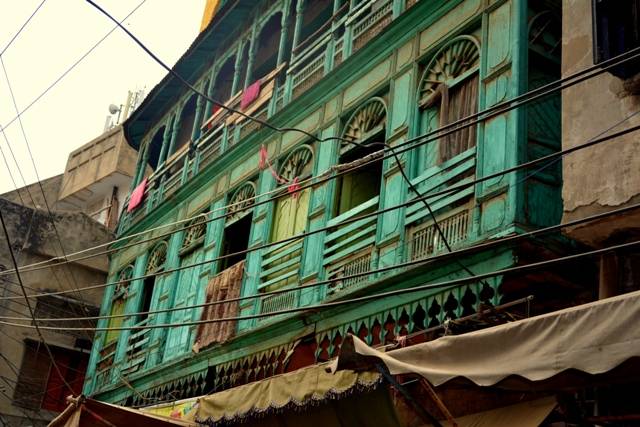
Bhatti Gate in the Walled City of Lahore was called the Chelsea of Lahore. You must be wondering why. Chelsea is an affluent area in London, England and is known to be London's bohemian quarter, the heart of artists, radicals, painters, actors and poets. In short, all the literary personalities and artists came from this area.
We were lucky to have such a place here in Lahore as well which was similar to the Chelsea of London. It's the Bhatti Gate inside the Walled City of Lahore. This is where the city’s poets, artists, herbal doctors, lawyers, writers and intellectuals lived for years. Some were born there and some migrated to this place after partition in 1947.
Let me tell you that it was Bhatti gate from where Sir Abdul Qadir started the publication of his influential literary magazine Makhzan, who can forget the importance of this magazine. Agha Hashr, the famous drama writer, Fasih Ul Mulk and Daag Dehlvi also lived here. Chaudhry Sir Shahab Ud Din, Punjabi poet and the speaker of Punjab Assembly and also resided inside the Bhatti Gate.
Faqir Syed Azizuddin and Faqir Syed Noor ud din, accomplished Persian poets also lived here. Famous Marsia orator and poet Syed Nazir Hussain Nazir Lakhnavi and Maulvi Ahmed Din also resided in the Bhatti Gate.
Now enter into Bhatti Gate with me and you will surely fall into an ocean of colours, literature, fragrances, visuals, sounds and feelings as soon as you cross the colonial-built Bhatti Gate. This gate is a lot more than architecture; it is a feeling and a trance. The more you get to know about this place, the more you indulge into it.
Bhatti Gate was one of the thirteen gates built by the third Mughal Emperor Akbar, to protect the Walled City of Lahore. It is one of the two oldest entrance points into the walled city which controlled the only major north-south thoroughfare during Ghaznavid time.
In the book Lahore ka Chelsea, Hakeem Ahmed Shuja states that the real name of the gate was Bhutti gate, and it was the point where Bhutti Warriors of Multan camped before the arrival of Mughals and with time, 'Bhutti' became 'Bhatti'. According to some books the gate was called Bhatti Gate as it was capital of the Emperor Raja Bhatti in ancient times. Another history reference narrates that the name of this gate is also the existence and settlement of Bhatti Clan who lived there for centuries.
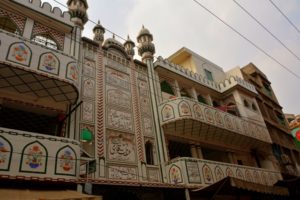
When you look at the present structure of Bhatti Gate you will have a feel of the colonial built. This is because it was rebuilt in British era after being destroyed by the Sikhs. Like Delhi and Lohari Gates, there are rooms inside this gate as well which are presently occupied by the local police station. The passage starting from Bhatti gate leads straight to Taxali bazaar via Bazaar-e-Hakeeman and Tehseel Bazaar. It is an amazing route which will mesmerise and attract you.
Bhatti Gate was once famous for literature and diversified performing arts. Today one can experience the glimpses of the elevated past while walking through the legendary streets and crossing the balconies and Havelis, each brick and stone of which, divulge a story, but we hardly see anything on ground. As the time passes, we are only left with memories because the cityscape has changed and many people have moved out of Bhatti Gate and have settled in other parts of the city.
Walking down the Bhatti gate trail, we come across Mohallah Patrangan. The name might sound strange to you, but it has a history. The locality was named after many cloth dyers who once lived there. In old days, the streets were named after famous castes, personalities or occupation of the residents. This is the place where Molvi Asghar Rohi, a guide to the knowledge of linguistics once lived. Dr. Muhammad Shafiq, the principal of Oriental College, was his student and also lived nearby.
A street named after Mollana Rohi is also located inside Bhatti Gate along with the Mosque built by him. Many of the professors of Oriental College lived in Bhatti Gate, but unfortunately the houses have been replaced by plazas now.
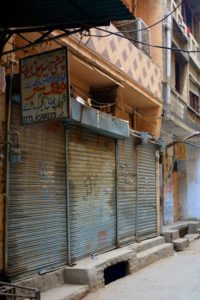
A little further down the lane, we see the Gali Nayian, where the eminent lawyers of those times lived. The remains are no more seen like many other buildings. These lawyers included people like Sheikh Gulab Din who had translated many Persian and English laws into Urdu.
Don’t miss to see the Victoria School there and Maidan Bhaiyan which is located right in front of Haveli Kanwar Nau Nehal Singh. The Haveli is now converted into Victoria Girls High School. There had been a garden at this place which was the part of the same haveli. With the passage of time, the garden was covered with buildings and houses and thus today there are no traces of it.
If you are looking for significant and superb examples of Sikh architecture in Lahore then you are at your destination “Haveli of Nau Nehal Singh”. This spectacular Haveli was the private home of the Prince Nau Nehal Singh who was the son of Maharaja Kharak Singh.
Today, this pompous Haveli is perhaps the showy of the surviving Havelis in Lahore. With a startling rectangular floor plan the building has a basement and four storyes above the ground level. The main entrance of the Haveli is from the street bounded by an open space named as “Bhaiyon ka Medaan”. Look around yourself and here you will find a typical Androon Lahore life in the open space.
The Haveli was taken over by the British government when Punjab was annexed in 1849 and converted into the first public school for girls, The Victoria School. The school has been used in many Pakistani films and dramas because of its exquisiteness and splendor.
Opposite Mohallah Jalotiyaan is the house the most important personality we can think of in Pakistan, the poet of the east, Dr. Allama Iqbal. The house, he lived in once, is now converted into the office of a local music band. All those poems that Iqbal wrote before going to England and later published in “Bang e Dara” were written while he was living there. Mohallah Jalotiyaan is considered an important locality of Bhatti Gate due to residences of known and educated personalities over here.
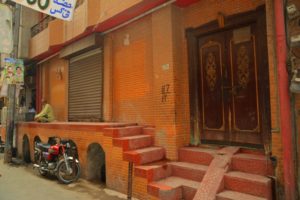
The other personalities who lived here for years included Maulvi Muhammad Din Foq, Tahir Lahori, Sir Abdul Qadir, Maulana Zafar Ali Khan, Shev Nath and Prem Nath. The name of Mohalla Jalotiyaan changed as Mohalla Aurangzeb after 1947. This Mohalla was a hub of teachers, lawyers, writers and poets.
Near this street is the Mohallah Chomalah where stands the majestic Oonchi Masjid. It was built on a towering platform and due to which it is known as ‘Oonchi’ It was built in the reign of Akbar the Great and associated with a water-carrier of Akbar’s time. This Mohalla got fame due to short stay of Sixth Guru of Sikh religion Guru Hargobind Sahib in a house of his Sikh follower over there. The house was later converted into a Gurdwara—congregational worship place of Sikhs.
There was water well in Mohalla Chomala. ‘Cho’ means four and ‘Mala’ stands for the pot being used to pull water from a well. Four Mala’s were erected on all four sides of the well because of which this Mohalla got its name as Mohalla Chomala۔ This area is now called Mohalla Ghosia. Near the same place is the shop where the famous Indian singer Rafi worked as a runner and a barber.
Koocha Shah Inayat is located near Oonchi Masjid and attributed to the name of Great Sufi Saint Hazrat Shah Inayat Qadri (R.A). Shah Inyat used to live here during the last days of Mughal Era. He was spiritual Pir of Baba Bulleh Shah. When Bulleh Shah came from Kasur to conciliate his Pir, he became the disciple of Hazrat Sha Inayat in the same mosque. He used to sit in the stairs of Oonchi Masjid.
Gali Khari Khoe is another interesting place. Almost a century back, there were water wells in the streets and Koochas of Walled City Lahore. People used to fetch water from these wells for their daily usages at homes. Gali Khari Khoi was named after a well having saltish water in the locality. In sub-continent big well was called as Kho and small well was termed as Khoi.
If you are roaming around in Bhatti Gate don’t miss Wun Wali Gali. Wun is a shady tree. Its branches stretch over large area but its wood is almost useless. It was commonly seen in mohallahs and streets beside open spaces during old times. Wun Wali Gali got fame as the tree (Wun) was planted here and people especially women used to sit under its shade during summer.
Thatti Malahan is another unique Mohallah with an interesting history. Boating was common in River Ravi in ancient time when old Lahore was almost at brink of eastern bank of the river. Tahatti Malahan got fame due to houses of boatmen in the area.
You will also come across the Mohallah Zaildaran. A Zaildar was an official designation introduced in British Period to control the internal affairs of the city. In this system, an appointed Zaildar was responsible to inform the government authorities about the activities within city. Moreover, he was responsible to give detail tour and experience of city life to the visitors. This Mohalla got its name due to residences of Zaildars over there.
Mohalla Islam Khan is the most ancient residential area of Muslim community in Bhatti Gate. It is said that the residents of this area converted to Islam on the preaching of Hazrat Ali Hajveri Data Ganj Baksh (R.A). Mohalla Islam Khan derived its name from Islam Khan—a known Muslim personality of the area.
=
Mohalla Sathan is another site of interest with an amazing history. In Persian language, the residential area of elites and respectable is called Sathan. Mohalla Sathan was the residential area of pure Hindu families where Hindu Pandit and Thakurs used to reside. There were some houses of Sikh and low caste Hindus as well. Known Hindus who contributed a lot in literary activities of the city were the residents of Mohalla Sathan.
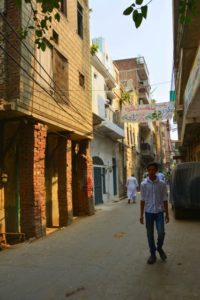
On the same road is the striking Sheesh Mahal Ghatti, where Syed Muhammad Shah lived. He was a lawyer and master of property laws in those times. Same is the place where Muhammad Hussain the physician of Viceroy of Lahore lived. There is the street of Mela Raam but his mansion does not exist now. He was an esteemed personality and was one of the contractors who built the Railway Station of Lahore.
In front of the same place is a picturesque Koocha called Moti Tibba. This is the place where Dr. Abdul Qadir lived for many years and his famous magazine 'Makhzan' was first issued from there in 1901. The initial edition of Makhzan was published with Iqbal’s first natural poem 'Hamala'. The 'Pesa Akhbar' was issued from this very place by Munshi Mehboob Alam.
A little further is the street of Pir Bhola where the famous allopathic physician of British era Dr. Allah Din lived. We also see the famous Jogi Mohallah inside Bhatti Gate where Muhammad Tufail lived. He was the founder of the famous literary collection 'Naqoosh'.
Faqir Khana, a private museum, is also located there. It is owned and curated by a family that is residing there for the last two centuries. Fakir Khana is a collection of private artifacts and antiquities in South Asia including treasures of art, paintings, sculptures, manuscripts, Chinese porcelain, Persian carpets and countless other masterpieces related to Sikh Era.
Opposite the museum is the Koocha Faqir Khana which derived its name from the family of influential Faqirs who were posted on important public offices during the Sikh Rule in Punjab. Syed Ghulam Ali Shah—the ancestor of Faqir Family—made Koocha Faqir Khana as his first abode and lived here till he breathed his last in 1756 A.D. His son, Syed Ghulam Mohyuddin Bokhari, succeeded him in the family, later established a clinic at his father’s residence and became popular as Nosha-e-Sani.
Inside this Koocha were houses of the Faqir Family and opposite to it is the famous Haveli Faqir Khana which was constructed during the early period of Sikh Rule. The Haveli is now converted into a museum decorated with rare collection and relics of Islamic eras as well as antiques of the Sikh Rule.
Close to the Museum is the Haveli of Begum Wajid Ali Shah which is still a residential property. Near the same place is the Imam Bargah of Sayeeda Mubarik Begam (wife of Syed Mratab Ali). The graves of Syed Mratab Ai Shah and his wife Sayeeda Mubarik Ali are in the compound of this mansion.
Today, a part of this haveli is turned into Naqsh School of Arts where the local students are trained, free of cost, in painting, calligraphy, fresco, and sculpturing. Near these Havelis, Hakeem Abdullah Ansari built a mosque and the Bazaar was also named after the same person.
There used to be literary and poetic sittings at Bazaar e Hakeeman in those days, famous intellectuals, scholars, poets, and politicians of Lahore such as Molana Muhammad Hassan Jalandhri, Sir Abdulqadir, Allama Iqbal, Sir Shahab Udin, Sir Muhammad Shah Din, Sir Muhammad Shafi, and Faqeer Iftikhar Udin were regular part of those sittings.
Near the Koocha Lal Haveli, comes the place where the renowned wrestler Muhammad Hassan known as Hassan Pehalwan lived. It was his son Hassan Muhammad Hayat who became the right hand of Maulana Muhammad Ali Johar Johar.
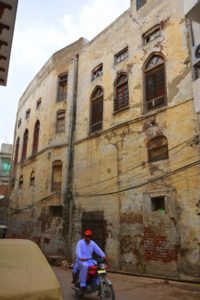
The mansion of Session Judge Syed Muhammad Latif, who is more famous because of his book Tareekh e Lahore, is also inside Bhatti gate and a bazaar is named after him. The press of Sir Shahab Udin was also in this Bazaar. The Muslim League representing newspaper named 'Khalid' was also born inside Bhaati. The owner of 'Tehzeeb e Niswan' Magazine Syed Mumtaz Ali is also among the big names who lived there. His house was in Koocha Tehseel.
Maulana Zafar Ali khan lived in Kucha Sabz peer when he returned from Hyderabad Dakan, and he issued a magazine called 'Punjab Review' from there. Famous Urdu poet Saghar Sidiqui also spent a great part of his life there. Bhaati has also been a home for famous Urdu Fiction writer Ghulam Abbas, Chaudhry Barkat Ali, and Nazeer Chaudhry, the editors of literary journals 'Adab e Lateef' and 'Sawera'. The writer Tahir Lahori also lived in Bhaati Gate.
Madrassa Nomanai and mosque are still intact inside Bhatti Gate. These are attributed with the Shah Jahan’s period, but the façade and interior have changed now.
Wrestling was a famous entertainment in vicinity of Bhatti Gate like other parts of the city. This area got fame due to residences of Pehalwans (Wrestlers) over here. These Pehalwans took part in famous wrestling of the sub-continent. Shafi Machine-man, Labha Pehalwan and Dita Pehalwan were the known wrestlers of Koocha Pehalwana of Bhatti Gate.
Koocha Kaghzian is another place inside Bhatti Gate. Here, for the first time paper making, press, book binding and other related works had started. This Koocha got recognition due to establishment of first paper industry over here. The papers were earlier being imported from Kashmir and Sialkot to Lahore. In 1870 when Ghulam Mohayudin Bokhari established his school and clinic here, he brought experts from Kashmir and Sialkot and settled in this Koocha.
You will also see Kocha Teer Garan which was the residence of fletchers (arrow makers) during Sikh Rule. Their main job was to provide arrows to Sikh Army on its demand.
There are countless artists, writers, poets, actors, musicians and sportsmen who were born in Bhatti Gate. This is where Lahore’s movie industry took birth. Mian Abdul Rashid Kardar, a resident of Bhatti Gate, made the first silent movie in Lahore and rose to great fame and fortune as one of the most successful filmmakers of India.
Bazaar-e-Hakeeman is the famous bazaar of Bhatti Gate. Hakeem Abdullah Ansari built a mosque and the Bazaar was also named after the same person. There used to be literary and poetic sittings at Bazaar e Hakeeman in those days. Famous intellectuals, scholars, poets, and politicians of Lahore such as Molana Muhammad Hassan Jalandhri, Sir Abdul Qadir, Allama Iqbal, Sir Shahab Ud din, Sir Muhammad Shah Din, Sir Muhammad Shafi, and Faqeer Iftikhar Ud din were regular part of those sittings.
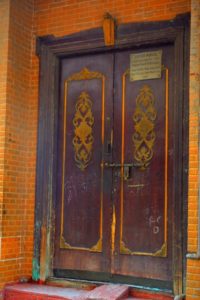
Of the great singers, Ali Bux Zahoor also came from Bhatti. The music composer Khawaja Khurshid Anwar was another Bhatti Gate man, as was the famous writer, Mirza Adeeb. Some of the greatest sportsmen and kabbadi players came from Bhatti Gate. The great wrestlers of all times such as Rustam-e-Zaman Gama Pehelwan and Rustam-e-Hind Imam Bux, were from Bhaati Gate. Another great wrestler of the times was Muhammad Shafi Pehelwan, a 'shagird' (student) of Rustam-e-Zaman Gama Pehelwan.
The great Skipper Abdul Hafiz Kardar, Pakistan’s celebrated cricket captain, a cousin of Abdul Rashid Kardar, also belonged to Bhaati Gate. He is one of the few cricketers to have played for more than one country. He was a member of the last team from undivided India to tour England in 1946.
Bhati Gate witnessed many historic glories. At present the place is changed into a food hub but you can still see the traces of the bygone days. People living there will also narrate the stories of past if you sit with them.
